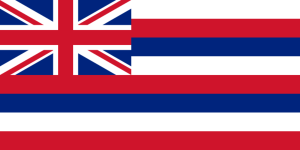Hawaii
Hawaii is the 50th and most recent U.S. state to join the United States. It joined the Union on August 21, 1959. It is the only U.S. state located in Oceania and the only one made up entirely of islands. There are no separately incorporated cities in the entire state; Honolulu is both a city and county.
- ABBREVIATION: HI
- NICKNAME: The Aloha State
- POPULATION: 1,404,054 (2013 est.)
- CAPITAL: Honolulu
- STATE BIRD: Nene
- STATE FLOWER: Hibiscus
- AREA: 10,931 sq. mi.
- TIME ZONE: Hawaii: UTC −10 (no DST)
- ENTERED UNION: Aug. 21, 1959
- ALTITUDE: High, 13,796 ft. Mauna Kea
- CLIMATE: Great variation on rainfall depending on trade winds. Windward slopes are wet, leeward slopes generally dry. Mild temperatures.


“We came from Hawaiki-the-Great” runs the ancient Polynesian chant, “from Hawaiki-the-Long, from Hawaiki-the-Distant.” So sang these far-roving South Pacific peoples as they sailed eastward, populating Samoa, Tonga, Bora-Bora, Tahiti and the Marquesas as they went. Sometime in the remote past, navigating by the stars in 70-foot double-hulled canoes, they came upon a vast island chain. They named the major island “Hawaiki”, as they had other islands at which they had paused on route.
Here was an ocean paradise. Gradually created by volcanic action over millenniums, the eight main islands and a string of 20 coral-fringed islets sweep 1,600 miles across the Pacific. In their rich lava soil, the starchy taro plant flourished in the warm sun. In time Hawaiki became Hawaii, and other peoples came-missionaries and whalers from New England; entrepreneurs to service the whalers; Japanese, Filipinos and Chinese to work vast plantations of pineapple and sugar cane.

Hawaii’s strategic location in the mid-Pacific dominates its economy. A large part of its labor force is employed on well know military installations like the Navy’s Pearl Harbor. Agriculture has been a declining industry, for the plantation operators found that rising costs made it difficult to compete with continental U.S. and far eastern growers. But the land itself-lulled by the northeast trades, its palm-clad slopes rising towards the Pacific sky- remains a paradise, recalling Mark Twain’s description: “…the loveliest fleet of islands that lie anchored in any ocean.
FUN FACTS:
- More animals and plants native to Hawaii are on the endangered species list than in any other state. Even its state bird is endangered.
- There are only 12 letters in the Hawaiian alphabet: A, E, I, Q, U, H, K, L, M, N, P, and W.
- There are no racial or ethnic minorities in Hawaii. Everyone is a minority.
- You can ski two different ways on the same day in Hawaii: on water at the beach and on snow on the slopes of Mauna Kea, a 13,796 foot-high volcano on the big island.
- Mount Waialeale, on the island of Kauai, is the wettest place in the United States, with 460 inches of rainfall per year.
- Hawaii’s state fish is the Humuhumunukunukuakua’a, or trigger fish.
